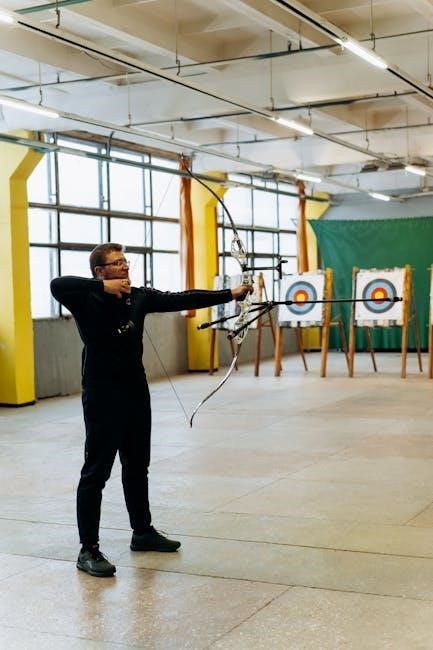The Wheel of Consent, created by Dr. Betty Martin, is a model exploring touch dynamics, distinguishing between the doer and receiver. It offers a framework for clear, consensual interactions, with resources like the 3-Minute Game available in the Wheel of Consent PDF, providing practical tools for understanding and applying its principles.
1.1 What is the Wheel of Consent?
The Wheel of Consent is a transformative model developed by Dr. Betty Martin, designed to clarify and navigate the dynamics of touch and interaction. It distinguishes between the “doing” and “gift” aspects of touch, emphasizing who is initiating (the doer) and who the action is for (the receiver). This framework helps individuals understand consent as a spectrum, rather than a binary concept, fostering clearer communication and boundaries. By exploring the four quadrants—Taking, Giving, Receiving, and Allowing—the Wheel provides a practical tool for enhancing emotional intimacy, respect, and awareness in all forms of connection, whether sexual or non-sexual.
1.2 Importance of Understanding Consent Dynamics
Understanding consent dynamics is essential for fostering healthy, respectful, and mutually satisfying interactions. The Wheel of Consent provides a clear framework for navigating touch and connection, emphasizing the importance of clear communication and boundaries. By distinguishing between doing and receiving, it helps individuals recognize their own desires and comfort levels, while respecting those of others. This model encourages emotional intimacy, reduces misunderstandings, and promotes a culture of consent as an ongoing, dynamic process. Mastering these dynamics enhances relationships, builds trust, and empowers individuals to engage with confidence and clarity in all interactions, whether intimate or casual.

Origin and Development of the Wheel of Consent
Developed by Dr. Betty Martin, the Wheel of Consent emerged from her extensive experience as a body-worker. It clarifies touch dynamics, enhancing communication and mutual understanding in interactions.
2.1 Creator: Dr. Betty Martin
Dr. Betty Martin, a renowned body-worker with over three decades of experience, developed the Wheel of Consent. Observing clients’ struggles with touch communication, she created this model to clarify dynamics like giving, receiving, and allowing. Her work emphasizes consent as a spectrum, fostering clear boundaries and emotional intimacy. The Wheel of Consent PDF outlines her framework, providing tools like the 3-Minute Game to navigate touch interactions consciously. Her approach has transformed how individuals and professionals understand and engage in consensual touch, promoting authenticity and respect in all relationships.
2.2 Background and Purpose
The Wheel of Consent emerged from Dr. Betty Martin’s extensive experience as a body-worker, where she observed widespread struggles in communication about touch. Designed to clarify consent dynamics, it provides a framework for understanding interactions as exchanges of touch or energy. The model distinguishes between doing and gifting, emphasizing respect for boundaries and comfort. Its purpose is to foster clear, respectful interactions, ensuring all parties feel heard and honored; By addressing these dynamics, the Wheel of Consent aims to enhance intimacy, reduce misunderstandings, and promote authenticity in all relationships, not limited to touch but applicable to broader human connections.
Key Concepts of the Wheel of Consent
The Wheel of Consent explores touch dynamics, distinguishing between doing and gifting, and emphasizes consent as a spectrum with clear boundaries and communication.
3.1 The Doing and Gift Aspects of Touch
The Wheel of Consent distinguishes between the “doing” aspect, focusing on who initiates touch, and the “gift” aspect, emphasizing who the touch is for. This distinction clarifies touch dynamics, ensuring actions align with both parties’ intentions and comfort, fostering mutual understanding and respect in interactions.
3.2 Consent as a Spectrum
Consent, as viewed through the Wheel of Consent, exists on a spectrum rather than being a static yes or no. This model illustrates that consent can vary in intensity and context, emphasizing flexibility and continuous communication. It’s not a one-time agreement but an ongoing process where boundaries and comfort levels may shift. The Wheel visualizes this spectrum, helping individuals understand that consent can be negotiated and withdrawn at any moment. This perspective fosters deeper respect and awareness in interactions, ensuring that all parties remain comfortable and willing participants. By recognizing consent as a spectrum, the Wheel promotes clearer, more empathetic connections in all types of relationships.
3.3 Boundaries and Communication
Boundaries and communication are foundational to the Wheel of Consent, ensuring interactions are respectful and consensual. Clear boundaries define what is acceptable and what is not, while open communication ensures both parties understand and honor these limits. The Wheel emphasizes that boundaries are not rigid but can evolve, requiring ongoing dialogue to maintain mutual comfort. Effective communication involves active listening and transparency, allowing individuals to express their needs and desires without assumption. By prioritizing boundaries and communication, the Wheel fosters trust, safety, and clarity, creating a framework for interactions that are authentic and deeply respectful of all parties involved.

Understanding the Four Quadrants
The Wheel of Consent divides interactions into four quadrants: Taking, Giving, Receiving, and Allowing. Each quadrant clarifies roles and intentions, enhancing clarity and harmony in connections.
4.1 Taking: The Act of Initiating
Taking involves initiating an action, such as touching, with clear intent and respect for boundaries. It requires the initiator to be attuned to the receiver’s comfort and consent, ensuring mutual agreement. This quadrant emphasizes the importance of clarity in one’s actions and the responsibility to communicate desires effectively. By focusing on taking, individuals can engage in interactions with confidence and respect, fostering trust and connection. The Wheel of Consent PDF provides insights into this dynamic, helping individuals navigate the complexities of taking with mindfulness and consideration.
4.2 Giving: The Act of Offering
Giving is the act of offering touch or actions with the intention of providing pleasure or comfort to another. It involves being attentive to the receiver’s boundaries and ensuring their consent is actively given. This dynamic emphasizes the importance of clarity and respect in interactions, fostering trust and connection. The giver must remain aware of their own limits and communicate openly to ensure mutual comfort. The Wheel of Consent PDF offers insights into this quadrant, providing guidance on how to navigate giving with mindfulness and respect for both parties’ needs and desires.
4.3 Receiving: The Act of Accepting

Receiving is the act of openly accepting touch or actions, focusing on one’s own comfort and pleasure. It involves being fully present and willing to experience what is offered. The receiver’s role is to communicate their desires and boundaries clearly, ensuring the interaction remains consensual and enjoyable for both parties. This dynamic highlights the importance of active participation and mindfulness in accepting what is given. The Wheel of Consent PDF emphasizes that receiving is not passive but rather an intentional act that fosters connection and trust, allowing both giver and receiver to thrive in the interaction.
4.4 Allowing: The Act of Permitting
Allowing is the act of giving permission for something to happen, often involving surrender or letting go. It is a form of consent where one person agrees to another’s actions, creating a dynamic of trust and vulnerability. Unlike receiving, which focuses on accepting for one’s own pleasure, allowing centers on permitting the other person to take the lead. The Wheel of Consent PDF illustrates this as a passive yet intentional act, requiring clear communication and mutual understanding. Allowing fosters deep emotional connections and respect for boundaries, ensuring both parties feel safe and valued in the interaction.

Practical Applications of the Wheel
The Wheel of Consent offers practical tools like the 3-Minute Game, enabling individuals to explore touch dynamics and consent in real-life interactions. The PDF provides exercises for implementation.
5.1 The 3-Minute Game: A Practical Exercise
The 3-Minute Game is a simple yet powerful exercise from the Wheel of Consent PDF, designed to clarify touch dynamics. One person initiates touch while the other receives, ensuring clear communication about comfort and boundaries. This game helps distinguish between giving and receiving, enhancing consent and intimacy. It encourages active dialogue, making it easier to navigate interactions with confidence. By focusing on who is “doing” and who is “receiving,” participants gain clarity on their desires and limits. The exercise is a practical way to apply the Wheel’s principles, fostering deeper connection and mutual respect in relationships.
5.2 Using the Wheel in Daily Interactions
The Wheel of Consent extends beyond touch, offering a framework for everyday interactions. It encourages clarity in communication, helping individuals understand their own and others’ boundaries. By distinguishing between “doing” and “receiving,” the Wheel fosters mutual respect and authenticity. In daily life, this model can enhance intimacy, improve collaboration, and reduce misunderstandings. It teaches individuals to prioritize consent in all exchanges, whether physical or emotional. This approach promotes healthier relationships by ensuring both parties feel heard and respected. The principles from the Wheel of Consent PDF provide practical guidance for navigating interactions with greater awareness and empathy.
Benefits of the Wheel of Consent
The Wheel of Consent enhances emotional intimacy, improves communication, and fosters clarity in relationships. It promotes mutual respect, reduces misunderstandings, and empowers individuals to express their needs and boundaries effectively.
6.1 Enhanced Emotional Intimacy
The Wheel of Consent fosters deeper emotional intimacy by clarifying touch dynamics. It helps individuals understand whether they are giving or receiving, ensuring both parties feel comfortable and respected. This clarity reduces misunderstandings and builds trust, allowing for more authentic connections. By prioritizing mutual consent, the Wheel encourages open communication, which strengthens emotional bonds. It also helps individuals recognize and honor each other’s boundaries, creating a safe space for vulnerability and connection. This leads to more satisfying and meaningful interactions, enriching relationships on all levels. The Wheel’s principles promote empathy and understanding, essential for nurturing emotional intimacy in any relationship.
6.2 Improved Communication Skills
The Wheel of Consent significantly enhances communication skills by fostering clarity and awareness in interactions. It teaches individuals to distinguish between giving, receiving, and allowing, ensuring mutual understanding. By encouraging open dialogue about desires and boundaries, the Wheel promotes honest expression and active listening. This framework helps individuals navigate conversations with confidence, reducing misunderstandings. The 3-Minute Game, a practical exercise from the Wheel of Consent PDF, further refines these skills by focusing on clear requests and responses. Improved communication leads to more harmonious relationships, as both parties feel heard and respected. This tool empowers individuals to express their needs effectively, fostering deeper connections and collaboration.
6.3 Effective Conflict Resolution
The Wheel of Consent offers a powerful framework for resolving conflicts by fostering mutual respect and understanding. It encourages individuals to communicate their needs and boundaries clearly, reducing misunderstandings. By distinguishing between giving, receiving, and allowing, the Wheel helps parties in conflict address issues without resentment. Active listening and clarity in requests and responses are key, ensuring both sides feel heard. This approach prevents conflicts from escalating by addressing them at their root. The 3-Minute Game, detailed in the Wheel of Consent PDF, provides practical training in navigating these dynamics. Ultimately, the Wheel promotes resolutions that honor both parties’ boundaries, fostering respectful and collaborative outcomes.

Real-World Applications
The Wheel of Consent is applied in sexual intimacy, non-sexual touch, and professional settings. It clarifies boundaries, enhancing communication and ensuring mutual comfort, as detailed in the PDF guide.
7.1 Sexual Consent and Intimacy
The Wheel of Consent is invaluable in sexual intimacy, offering clarity on boundaries and desires. It distinguishes between giving and receiving, ensuring mutual comfort and pleasure. By focusing on who is “doing” and who it’s “for,” the model prevents assumptions and fosters open dialogue. The 3-Minute Game, detailed in the PDF, helps partners navigate consent dynamically, exploring comfort zones and preferences. This tool enhances emotional intimacy, ensuring interactions are consensual and fulfilling for both parties, while respecting personal and cultural boundaries.
7.2 Non-Sexual Touch and Connection
The Wheel of Consent extends beyond sexual contexts, offering a framework for navigating non-sexual touch and connection. It clarifies the dynamics of giving and receiving, ensuring comfort and mutual understanding in interactions like hugging, holding hands, or therapeutic touch. By distinguishing who is “doing” and who it’s “for,” the model promotes clear communication and respect for boundaries. The 3-Minute Game, detailed in the PDF, can be adapted to explore comfort and preferences in non-sexual touch, fostering trust and emotional connection. This approach honors cultural and personal boundaries, making it a versatile tool for enhancing relationships in various settings;
7.3 Professional and Therapeutic Settings
The Wheel of Consent is invaluable in professional and therapeutic settings, providing a clear framework for touch-based interactions. It helps practitioners navigate boundaries, ensuring ethical and respectful care. By distinguishing the “doing” and “gift” aspects of touch, professionals can clarify their role and the client’s needs, enhancing trust and safety. The 3-Minute Game, detailed in the PDF, offers practical exercises to train therapists and bodyworkers in consent dynamics. This model supports compliance with professional standards while fostering deeper client-practitioner connections, ensuring mutually beneficial and respectful interactions in therapeutic environments. It’s a powerful tool for maintaining ethical integrity and promoting client well-being in professional care settings.

Challenges and Considerations
Implementing the Wheel of Consent requires overcoming communication barriers and respecting cultural boundaries. It demands active listening and empathy to navigate diverse comfort levels and expectations effectively.
8.1 Overcoming Communication Barriers
Overcoming communication barriers is essential for effective consent dynamics. Misunderstandings and unspoken expectations can hinder clarity, while fear of rejection or judgment may prevent open dialogue. Cultural differences and personal inhibitions further complicate interactions. Active listening, empathy, and non-judgmental questioning are key strategies to address these challenges. Encouraging individuals to express their needs and boundaries clearly fosters trust and understanding. Creating a safe, respectful environment where consent can be freely negotiated and renegotiated is crucial. By addressing these barriers, individuals can navigate consent dynamics more effectively, ensuring mutual respect and understanding in all interactions.

8.2 Cultural and Personal Boundaries
Cultural and personal boundaries significantly influence consent dynamics. Different cultures may have varying norms around touch, communication, and consent, requiring sensitivity and awareness. Personal boundaries, shaped by individual experiences and values, must also be respected. Power dynamics, societal expectations, and past traumas can further complicate interactions. Respecting these boundaries involves understanding and honoring each person’s unique limits. Active communication and empathy are essential to navigate these differences effectively. Ignoring cultural or personal boundaries can lead to misunderstandings or harm, emphasizing the importance of mutual respect in all interactions. The Wheel of Consent encourages a deeper understanding of these factors to foster safe and consensual connections.
Resources for Learning
The Wheel of Consent PDF and additional guides provide comprehensive tools for understanding and applying the model. Resources include diagrams, exercises, and detailed explanations to enhance learning and practical application.
9.1 The Wheel of Consent PDF
The Wheel of Consent PDF is a comprehensive resource that outlines the model’s core principles and practical applications. It includes the iconic Wheel diagram, which visually explains the four quadrants of consent: Taking, Giving, Receiving, and Allowing. The PDF also provides detailed explanations of each quadrant, helping users understand the nuances of touch dynamics and consent. Additionally, it offers practical exercises, such as the 3-Minute Game, to apply the model in real-life interactions. Available for immediate download, the PDF serves as a valuable tool for individuals and professionals seeking to deepen their understanding of consent and improve communication in all relationships.
9.2 Additional Materials and Guides
Beyond the Wheel of Consent PDF, numerous additional resources are available to deepen understanding and application. Workshops, online courses, and guided exercises offer interactive learning opportunities. These materials explore the four quadrants in detail, providing practical strategies for navigating consent dynamics. Community forums and discussion groups also provide spaces for sharing experiences and gaining insights. Supplementary guides often include reflective exercises and real-life scenarios to enhance comprehension. These resources cater to both personal growth and professional development, making the Wheel of Consent accessible and actionable for diverse audiences seeking to improve their relational skills and communication abilities.
The Wheel of Consent offers a transformative framework for understanding touch dynamics, enhancing intimacy, and fostering clear communication. Its practical tools and resources empower individuals to navigate interactions with clarity and authenticity, promoting deeper connections and respect for boundaries in all relationships.
10.1 Recap of Key Points
The Wheel of Consent, developed by Dr. Betty Martin, is a powerful model clarifying touch dynamics, emphasizing the distinction between the doer and receiver. It highlights consent as a spectrum, not a binary choice, and underscores the importance of boundaries, communication, and flexibility. The four quadrants—Taking, Giving, Receiving, and Allowing—provide a structured approach to understanding interactions. Practical tools like the 3-Minute Game and the Wheel of Consent PDF offer actionable steps to apply these principles. By fostering clarity and authenticity, the Wheel enhances emotional intimacy, improves communication, and empowers individuals to navigate relationships with respect and awareness, making it a invaluable resource for personal and professional growth.
10.2 Encouragement for Further Exploration
Exploring the Wheel of Consent offers a transformative journey toward deeper connections and understanding. The Wheel of Consent PDF and related resources provide practical tools to navigate touch dynamics, enhancing emotional intimacy and communication. By engaging with these materials, individuals can cultivate healthier relationships and personal growth. The 3-Minute Game and other exercises encourage active learning and self-reflection. Embrace this opportunity to expand your understanding of consent and its role in daily interactions. Continuous exploration will empower you to communicate more effectively, fostering respect and clarity in all aspects of life, leading to more authentic and fulfilling connections.